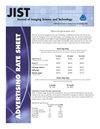基于可接受性的品牌色彩容忍度案例研究
IF 0.5
4区 计算机科学
Q4 IMAGING SCIENCE & PHOTOGRAPHIC TECHNOLOGY
Journal of Imaging Science and Technology
Pub Date : 2022-05-01
DOI:10.2352/j.imagingsci.technol.2022.66.3.030509
引用次数: 0
摘要
. 彩通R (cid:13)配方指南(或称指南),使用特殊配方的油墨在指定的基材上印刷,已被各品牌广泛用于指定品牌色彩目标。虽然《指南》没有提及品牌色彩容忍度,但影响品牌色彩容忍度的两个相互竞争的标准,即可感知性和可接受性。基于感知的颜色容忍度关注的是“我能看到区别吗?”而容许差位于刚可察觉差(JND)区。基于可接受性的色彩容忍度,关注“我能接受结果吗?”,需要适合用例来确定什么是刚刚可接受的差异(JAD)。本研究没有进行心理测量测试,而是使用由2140种CIELAB颜色组成的2019年潘通R (cid:13)配方(涂层)指南,并对“相邻色差”进行数据分析,以研究什么是基于可接受度的色彩容限。结果表明,基于可接受度的颜色容忍度(3 (cid:49) e00)比基于感知度的颜色容忍度(2 (cid:49) e00)有更大的余量。本文章由计算机程序翻译,如有差异,请以英文原文为准。
Acceptability-based Brand Color Tolerance, A Case Study
. The Pantone R (cid:13) Formula Guide (or Guide), printed using specially-formulated inks on specified substrates, has been used widely by brands to specify brand color aims. While the Guide is silent on brand color tolerance, there are two competing criteria that influence the brand color tolerance, i.e., perceptibility and acceptability. Perceptibility-based color tolerance focuses on “Can I see the difference?” and the permissive difference is in the just-noticeable difference (JND) region. Acceptability-based color tolerance, focusing on “Can I accept the outcome?”, requires fit-for-use cases to identify what the just-acceptable difference (JAD) is. Instead of conducting psychometric tests, this research uses the 2019 Pantone R (cid:13) Formula (Coated) Guide, consisting of 2140 CIELAB colors, and data analyses of the “neighboring color difference” to investigate what is the acceptability-based color tolerance. The result shows that the acceptability-based color tolerance (3 (cid:49) E 00 ) has more margin than the perceptibility-based color tolerance (2 (cid:49) E 00 ).
求助全文
通过发布文献求助,成功后即可免费获取论文全文。
去求助
来源期刊

Journal of Imaging Science and Technology
工程技术-成像科学与照相技术
CiteScore
2.00
自引率
10.00%
发文量
45
审稿时长
>12 weeks
期刊介绍:
Typical issues include research papers and/or comprehensive reviews from a variety of topical areas. In the spirit of fostering constructive scientific dialog, the Journal accepts Letters to the Editor commenting on previously published articles. Periodically the Journal features a Special Section containing a group of related— usually invited—papers introduced by a Guest Editor. Imaging research topics that have coverage in JIST include:
Digital fabrication and biofabrication;
Digital printing technologies;
3D imaging: capture, display, and print;
Augmented and virtual reality systems;
Mobile imaging;
Computational and digital photography;
Machine vision and learning;
Data visualization and analysis;
Image and video quality evaluation;
Color image science;
Image archiving, permanence, and security;
Imaging applications including astronomy, medicine, sports, and autonomous vehicles.
 求助内容:
求助内容: 应助结果提醒方式:
应助结果提醒方式:


